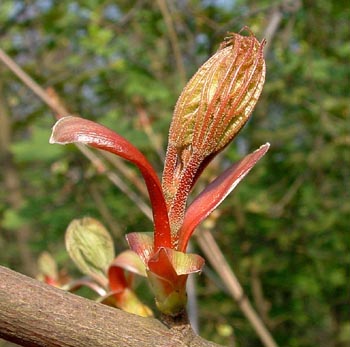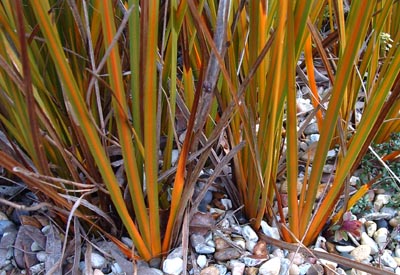5th May 2005 - Spring visitors
What a difference a couple of weeks of warm weather makes to plant growth. Right now itís exploding all around us. Every day is greener and more lush, and we can see that the hazel over the road is leafing out to the extent that the woods behind them will soon no longer be visible.
"...The Pulsatilla vulgaris had finished, but would the Dicentra spectabilis still be in full flower? ..."
Last weekend I had an American friend to stay. She hadnít been to our home here before, since we had met when Karl and I were working in the Netherlands and she and her partner were also living there for a year. Kim and I hit it off immediately and kept in touch by letter and phone, but we hadnít seen each other for three years. I was very much looking forward to showing her the lush spring growth.
As the date of her arrival came closer Iíd found myself watching plants and trying to estimate what would be looking good for her visit. The Pulsatilla vulgaris had finished, but would the Dicentra spectabilis still be in full flower? The Anemone nemorosa in the woods? Would the bluebells be looking their best yet? I really wanted the shrubs growing against the garden walls be in sufficient leaf to cover the dull grey bricksÖ
On a long walk through the woods I pointed out the unfurling ferns to Kim. She told me that many ferns grow around San Francisco, where she lives, but they are far larger and she estimated the size, holding her hands out to show height and spread. Her description of them seemed to indicate shuttlecock ferns, arching leaves growing up in a circle, in an elegant vase shape. I said that the ferns here were still very young but would soon be the same size as their cousins across the water. Living in that lush, warm climate plants donít die away in winter and the ferns stay green all year round.
It feels strange to me, the idea of constant growth. Waiting for the spring to start and for plants to begin growing again can be so frustrating, but for many people itís the most exciting and beautiful time of the year. Those first emerging green tufts and spikes suddenly exploding into leaf and flower after months of frigid bareness.

Young Sycamore leaf bud
"...in the nursery area the plants are displayed in groups, according to their preferred habitat..."
Kim loves gardening too and, although she hasnít become as nerdy about it as I have, we had plenty of plant talk. On Saturday, we drove out to my RHS teacherís excellent nursery in Winterton (http://www.westshores.co.uk/) where she specialises in grasses and hardy perennials. There is an attractive garden area where all the plants on sale can be seen growing in situ, while in the nursery area the plants are displayed in groups, according to their preferred habitat; you will find the sunny plants together, the dry shade plants together, and so on. This makes it easier to choose what to plant in a particular micro climate as suitable choices are right there before you.
I bought a couple of plants Iíve been lusting over for several weeks. Both will be comfortable in our one hot and sunny bed. One is Libertia peregrinans, which I first saw growing in the Gravel Garden at Beth Chattoís garden in Essex. A rhizomatous perennial from New Zealand, it is made up of tough strap-like tufts, about 40cm high, striped in green and orange. The bright colours are intensified by the sun shining through them. Hardy down to Ė5c, it grows at Harlow Carr, north of here, so it should survive here in our well drained soil.

Libertia pergrinans
"...the leaves have a downy covering of tiny silver hairs, giving each leaf the appearance of having a fine halo..."
The other plant is an usual Euphorbia, Euphorbia characias ĎPortuguese Velvet'. It was one of the plants of the week on the RHS course and I was struck by its glowing outline. Itís unusual because the leaves have a downy covering of tiny silver hairs, giving each leaf the appearance of having a fine halo. My specimen is currently just one fat stem crowned with leaves, but when itís matured it will form a compact dome. It is said that this plant forms tiny plantlets at the tops of its flower stems, which can be snipped off for propagation.
The collection of plants propagated late last year and early this year have suddenly started to put out new growth. Those Papaver orientale root cuttings that we took in January will soon be ready to pot on again. I first separated them about three weeks ago, thinking that the Acanthus spinosus roots must have died because they had put out no growth, but under the compost green shoots were emerging so they went back into pots and have already put up small leaves.
Two Bolivian Rainbow chilli plants that were over-wintered in the house now have fresh new leaves and little purple flower buds, and the Lemon Grass that was rooted and potted up last autumn is looking very promising. There are four pots, each pot holding three stems, and by late summer the pots should be filled with juicy stems, ready for the cooking pot.
Fresh Lemon Grass from the shop tastes good but when you take it straight from the garden the flavour is far more intense and lemony. I decided to have a go at growing it myself after reading a question in a gardening magazine on growing it from seed.
Bob Flowerdew advised the reader not to bother with seed but to buy a few stems and root them in water instead. In warm weather it takes two to three weeks for the roots to emerge, and another couple for the roots to form into a coiled ball, at which point they can be planted up. New stems shoot out from the base of the parent plant and, if they are kept in a warm and sunny spot, and fed regularly, the pot will soon be filled. Stems can easily be twisted off at the base without damaging the plant. If you like Lemon Grass itís well worth growing your own rather than relying on the supermarkets to stock it. I'm drooling already.
© Copyright Miranda Hodgson 2005